
Education has been a key part of human progress and development since the dawn of civilization. Passing down and growing knowledge improves our lives in countless ways and continues to solve the most daunting challenges. Access to education, once only available to the wealthy and connected, is now a fundamental right in most parts of the world.
To identify the most educated countries in the world, 24/7 Wall St. reviewed tertiary education data for different age groups from the Organisation for Economic Co-operation and Development. Total adult higher educational attainment, as well as tertiary education for age groups 25-34 and 55-64 is from the OECD, and is for the most recent year available for each country. Working age population (ages 15-64) and the 2018 total population were also from the OECD.
Many of the countries on this list take very different approaches to education. Some use a more hands-off method that encourages personal development over work-related skills. Others are more structured and use uniform curriculums and standardized ways of testing. Whatever the method, it’s always important that students have enough resources and attention to learn and grow.
The earliest universities and schools were normally tied to religious institutions. A few of these universities are still active today and have been around for more than 1000 years. In the United States, the first universities were founded in the 1600s and the oldest public university was created in 1789. Check out the list of the oldest universities in the world.
Early education can be an essential part of a child’s development. However, around the world people differ on what exactly early education should look like. Some believe it’s best to let children be children and revolve learning around play and cooperation. Other methods introduce more structure to try and prepare children for education at the next level. These are the states with the best and worst early education.
Click here to see the most educated countries in the world
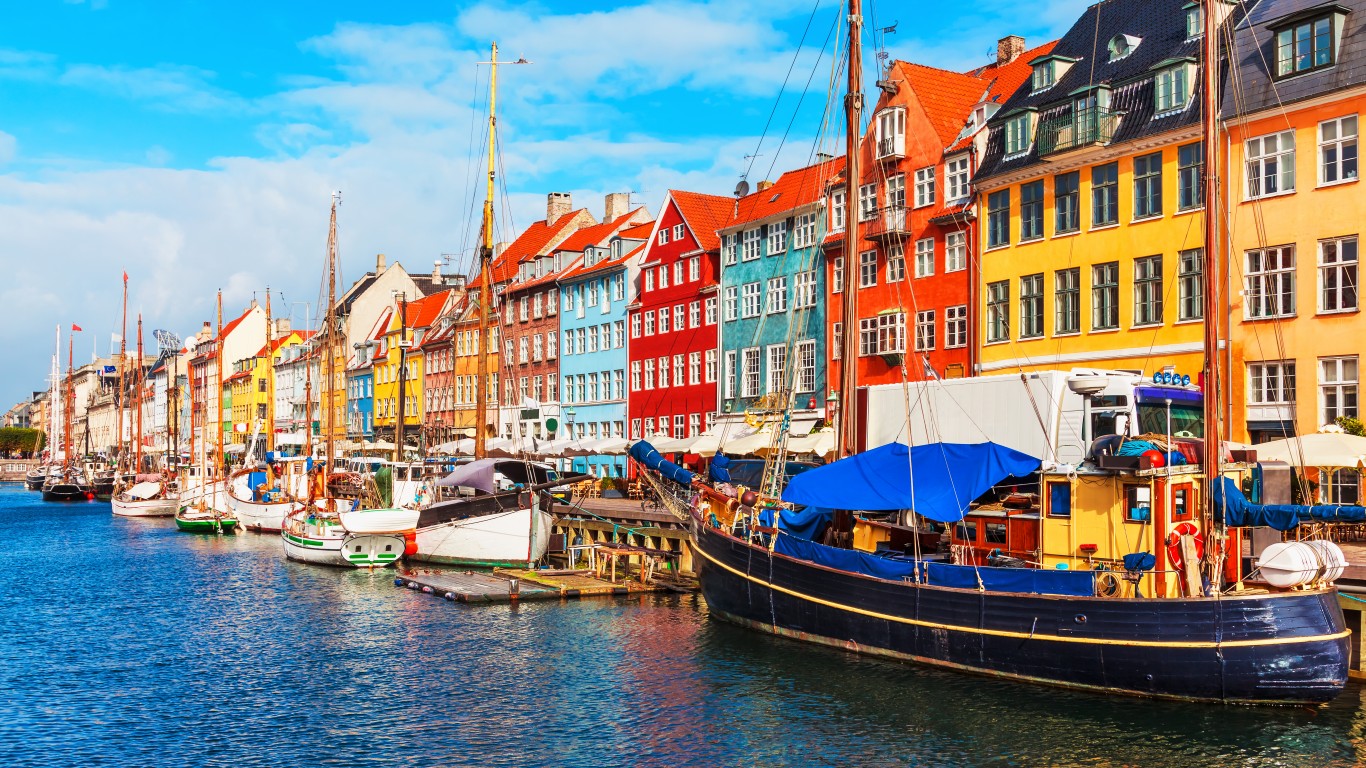
20. Denmark
> Adult higher education attainment, 2019: 40.4%
> 25-34 year-olds with tertiary education, 2019: 47.1% — #19 out of 43 OECD countries
> 55-64 year-olds with tertiary education, 2019: 30.8% — #20 out of 43 OECD countries
> Pct. of population of working age (age 15-64), 2018: 64.0% — #33 out of 43 OECD countries
> 2018 Population: 5.79 million — #31 out of 43 OECD countries
Scandinavian countries feature prominently on this list. In Denmark higher education is free and students can even receive stipends for related studying and living expenses. Students from the EU can also attend universities in Denmark for free. Denmark is a popular destination for international students partly because many programs are offered in English. Furthermore, the country speaks English at a high rate.
[in-text-ad]

19. Iceland
> Adult higher education attainment, 2020: 40.6%
> 25-34 year-olds with tertiary education, 2020: 38.3% — #31 out of 43 OECD countries
> 55-64 year-olds with tertiary education, 2020: 31.3% — #18 out of 43 OECD countries
> Pct. of population of working age (age 15-64), 2018: 66.7% — #12 out of 43 OECD countries
> 2018 Population: 353,000 — #43 out of 43 OECD countries
Iceland has a small population, and they do a good job of offering it educational opportunities. But a strong education system is not new in Iceland. The island nation has had a universal literacy rate since the end of the 18th century. The majority of Icelandic children attend preschool and fees are often heavily subsidized by the government. Primary and secondary education is provided by the government and universities are affordable.

18. Estonia
> Adult higher education attainment, 2020: 42.2%
> 25-34 year-olds with tertiary education, 2020: 43.1% — #26 out of 43 OECD countries
> 55-64 year-olds with tertiary education, 2020: 39.2% — #8 out of 43 OECD countries
> Pct. of population of working age (age 15-64), 2018: 64.0% — #33 out of 43 OECD countries
> 2018 Population: 1.32 million — #41 out of 43 OECD countries
Formal education in Estonia dates back to the 13th century when the first monastic and cathedral schools were founded. The oldest functioning university is the University of Tartu which was founded in 1632. The country strives to give all its citizens access to high quality education and has been successful in increasing education equity. The system is currently based on four levels starting from preschool to higher education.

17. Belgium
> Adult higher education attainment, 2020: 42.4%
> 25-34 year-olds with tertiary education, 2020: 48.5% — #16 out of 43 OECD countries
> 55-64 year-olds with tertiary education, 2020: 32.2% — #15 out of 43 OECD countries
> Pct. of population of working age (age 15-64), 2018: 64.2% — #31 out of 43 OECD countries
> 2018 Population: 11.40 million — #22 out of 43 OECD countries
Belgium has three national languages. The country is mainly divided into a French-speaking part and a Dutch-speaking part but there is also a small German-speaking area. Students learn the languages of parts besides their own as well as English. The small country has had a complicated history with education, including two so-called “School Wars” that caused political crises over the role religious institutes play in education.
[in-text-ad-2]

16. Netherlands
> Adult higher education attainment, 2020: 42.6%
> 25-34 year-olds with tertiary education, 2020: 52.3% — #11 out of 43 OECD countries
> 55-64 year-olds with tertiary education, 2020: 32.2% — #16 out of 43 OECD countries
> Pct. of population of working age (age 15-64), 2018: 65.0% — #26 out of 43 OECD countries
> 2018 Population: 17.23 million — #21 out of 43 OECD countries
The Netherlands is known for canals, windmills, and vice. However, the small country also has a strong education system and has done a great job of investing in its citizens. The nation is known for having a very high level of bilingualism, with many of its residents being fluent in English. The nation was traditionally made up of traders and craftsmen, oftentimes relying on business arrangements with its larger neighbors.
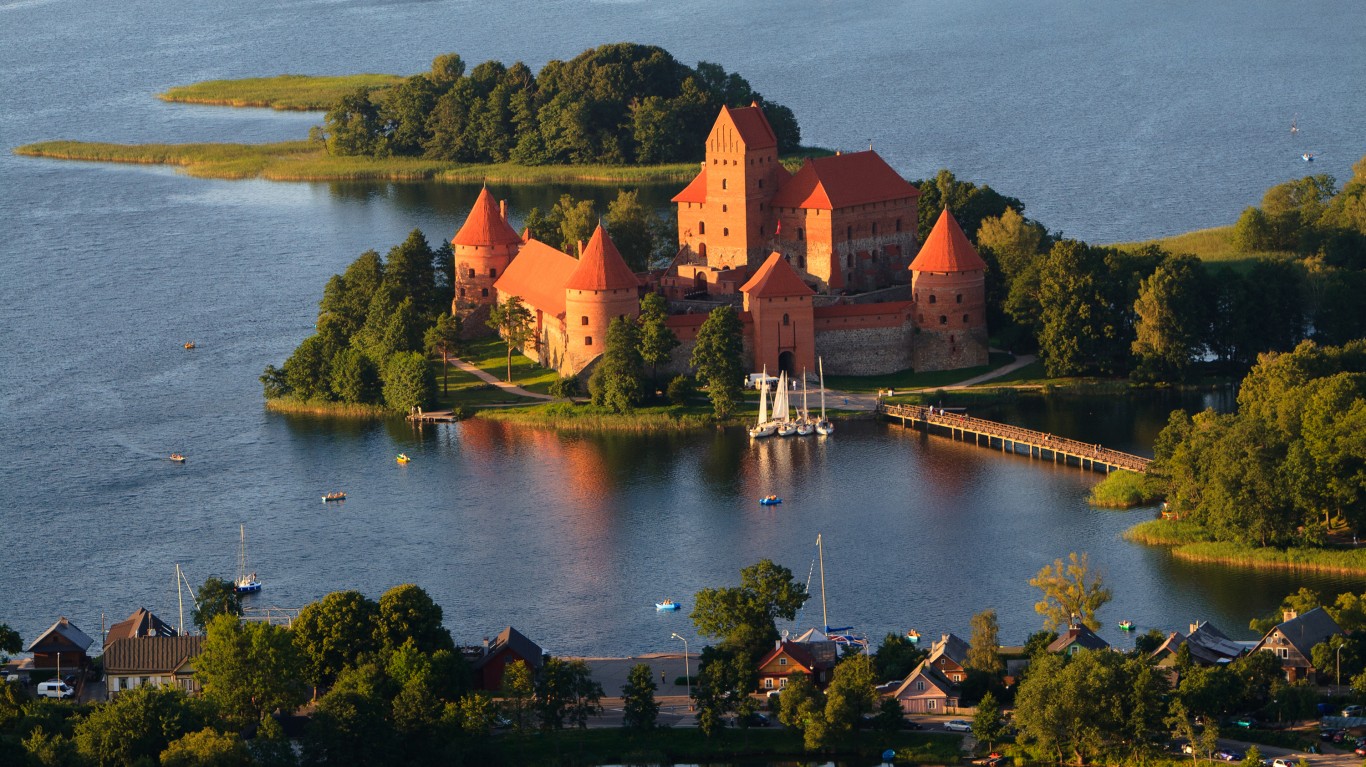
15. Lithuania
> Adult higher education attainment, 2020: 44.1%
> 25-34 year-olds with tertiary education, 2020: 56.2% — #7 out of 43 OECD countries
> 55-64 year-olds with tertiary education, 2020: 31.3% — #19 out of 43 OECD countries
> Pct. of population of working age (age 15-64), 2018: 65.2% — #25 out of 43 OECD countries
> 2018 Population: 2.80 million — #38 out of 43 OECD countries
The Baltic countries also feature prominently on this list. The education system in Lithuania was developed in the 16th century and continues to thrive. Vilnius University was founded in 1579 and is the oldest university in the country and region. The country’s first ministry of education was set up in 1773 and was responsible for running Lithuania’s education system. After the breakup of the Soviet Union, Lithuania continued to expand and improve its education system.
[in-text-ad]

14. Sweden
> Adult higher education attainment, 2020: 44.6%
> 25-34 year-olds with tertiary education, 2020: 49.1% — #15 out of 43 OECD countries
> 55-64 year-olds with tertiary education, 2020: 32.6% — #14 out of 43 OECD countries
> Pct. of population of working age (age 15-64), 2018: 62.4% — #39 out of 43 OECD countries
> 2018 Population: 10.18 million — #26 out of 43 OECD countries
The second Scandinavian country to make this list, the region is usually highlighted for its focus on education, transportation, healthcare, and a general high standard of living. Children are required to attend school starting at age 6 until at least age 16. Preschool is provided by the government for children ages 1 to 5 and emphasizes play as an important way for children to develop.

13. Norway
> Adult higher education attainment, 2020: 45.3%
> 25-34 year-olds with tertiary education, 2020: 50.8% — #13 out of 43 OECD countries
> 55-64 year-olds with tertiary education, 2020: 34.5% — #11 out of 43 OECD countries
> Pct. of population of working age (age 15-64), 2018: 65.3% — #23 out of 43 OECD countries
> 2018 Population: 5.31 million — #34 out of 43 OECD countries
Children in Norway are guaranteed a spot at preschool if their parents want to send them, and preschool is often subsidized by the government. After preschool, students attend public schools for free, including free higher education. Bachelor’s degrees normally take three years and students often take only a couple classes at once, focusing on a few specific topics over a short period of time.

12. Switzerland
> Adult higher education attainment, 2020: 45.3%
> 25-34 year-olds with tertiary education, 2020: 53.0% — #10 out of 43 OECD countries
> 55-64 year-olds with tertiary education, 2020: 34.7% — #10 out of 43 OECD countries
> Pct. of population of working age (age 15-64), 2018: 66.6% — #14 out of 43 OECD countries
> 2018 Population: 8.51 million — #30 out of 43 OECD countries
The mountain enclave has plenty of cash and they’ve put a lot of it into education. Public and private preschools exist in Switzerland and the public ones are free and often encouraged. Switzerland’s cantons are largely autonomous from the central government and usually decide how to run their education systems differently. However, they are all governed by the State Secretariat for Education, Research and Innovation.
[in-text-ad-2]

11. Finland
> Adult higher education attainment, 2020: 47.9%
> 25-34 year-olds with tertiary education, 2020: 44.7% — #22 out of 43 OECD countries
> 55-64 year-olds with tertiary education, 2020: 42.9% — #6 out of 43 OECD countries
> Pct. of population of working age (age 15-64), 2018: 62.3% — #40 out of 43 OECD countries
> 2018 Population: 5.52 million — #32 out of 43 OECD countries
The entire Scandinavian region makes this list and Finland is at the top. Finland’s constitution guarantees people the right to education and culture. Finland takes several innovative approaches to its education. For one, children do not attend school until they are 7 years old. This is to allow them more time to spend with family and friends when they are young. The system also minimizes homework and does not have children in school for longer than 20 hours a week. For-profit schools are illegal in the country and traditional private schools do not exist.

10. Australia
> Adult higher education attainment, 2020: 49.3%
> 25-34 year-olds with tertiary education, 2020: 54.6% — #9 out of 43 OECD countries
> 55-64 year-olds with tertiary education, 2020: 36.3% — #9 out of 43 OECD countries
> Pct. of population of working age (age 15-64), 2018: 65.5% — #19 out of 43 OECD countries
> 2018 Population: 24.99 million — #19 out of 43 OECD countries
In 2016, Australia ranked as the third largest provider of education to international students after the United States and United Kingdom according to the Australian Department of Foreign Affairs and Trade. The education system is broken into four levels with the last being nonmandatory higher education. Students attend primary and secondary education for most of their time in school and then spend two years in senior secondary school before graduating from the required portion of the school system.
[in-text-ad]
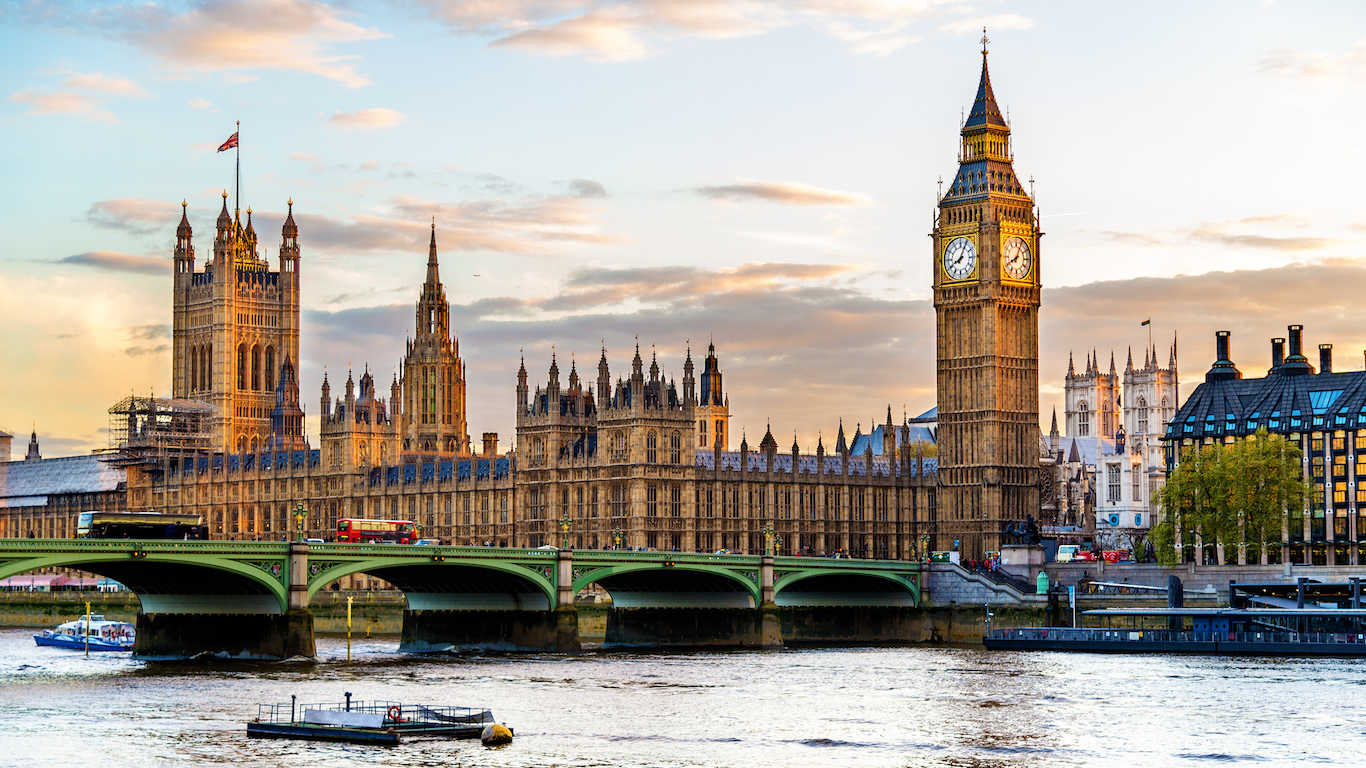
9. United Kingdom
> Adult higher education attainment, 2020: 49.4%
> 25-34 year-olds with tertiary education, 2020: 55.8% — #8 out of 43 OECD countries
> 55-64 year-olds with tertiary education, 2020: 39.4% — #7 out of 43 OECD countries
> Pct. of population of working age (age 15-64), 2018: 63.8% — #37 out of 43 OECD countries
> 2018 Population: 66.44 million — #10 out of 43 OECD countries
The United Kingdom is famous for its super prestigious boarding schools but the country also has put substantial resources into its wider education system. The British education system begins at age 5 and is compulsory until students are age 16. The pre-tertiary education system in the UK is split into four “Key Stages.” After students complete their mandatory education at age 16 they have the option to take certain tests that allow them to continue their education whether at a university or vocational school or beyond.

8. Ireland
> Adult higher education attainment, 2020: 49.9%
> 25-34 year-olds with tertiary education, 2020: 58.4% — #5 out of 43 OECD countries
> 55-64 year-olds with tertiary education, 2020: 33.4% — #13 out of 43 OECD countries
> Pct. of population of working age (age 15-64), 2018: 65.4% — #20 out of 43 OECD countries
> 2018 Population: 4.86 million — #37 out of 43 OECD countries
In Ireland, education is mandatory from ages 6 until 16 or until students have completed three years of second-level education. The system is composed of primary, secondary, third-level, and further education. Children can enter the education system as early as the first September following their 4th birthday. They are taught a variety of subjects, including the English, and Gaelic languages. Ireland’s education system has played a key role in bringing back the Gaelic language to the island nation.

7. United States
> Adult higher education attainment, 2020: 50.1%
> 25-34 year-olds with tertiary education, 2020: 51.9% — #12 out of 43 OECD countries
> 55-64 year-olds with tertiary education, 2020: 44.3% — #5 out of 43 OECD countries
> Pct. of population of working age (age 15-64), 2018: 65.4% — #20 out of 43 OECD countries
> 2018 Population: 327.17 million — #1 out of 43 OECD countries
The education system in the United States can differ substantially by state and city. Some have very high-quality public systems while others can be under-resourced and lacking. The university system is the strongest in the world and pumps out a substantial amount of research and degrees. However, affordability remains a massive and contentious issue, with many students taking on heavy debt to pay high tuition fees.
[in-text-ad-2]

6. Israel
> Adult higher education attainment, 2020: 50.1%
> 25-34 year-olds with tertiary education, 2020: 47.3% — #18 out of 43 OECD countries
> 55-64 year-olds with tertiary education, 2020: 46.1% — #3 out of 43 OECD countries
> Pct. of population of working age (age 15-64), 2018: 60.0% — #42 out of 43 OECD countries
> 2018 Population: 8.87 million — #28 out of 43 OECD countries
In Israel students attend class from Sunday to Thursday. The government provides free education for students from kindergarten to 12th grade. However, much of the funding comes from local sources which can lead to some disparities. Further, the complicated political situation can lead to large inequalities in the quality of education for individuals in the region. Israel has become a tech hub and many of its universities produce substantial research.

5. South Korea
> Adult higher education attainment, 2020: 50.7%
> 25-34 year-olds with tertiary education, 2020: 69.8% — #1 out of 43 OECD countries
> 55-64 year-olds with tertiary education, 2020: 25.1% — #27 out of 43 OECD countries
> Pct. of population of working age (age 15-64), 2018: 72.8% — #1 out of 43 OECD countries
> 2018 Population: 51.64 million — #13 out of 43 OECD countries
The South Korean educational system is divided into three parts. Students go to primary school for six years, middle school for three years and high school for another three years. Many schools and classes are often still divided by gender. The education system has substantial resources. However, pressure put on students to succeed can often be enormous.
[in-text-ad]

4. Luxembourg
> Adult higher education attainment, 2020: 51.3%
> 25-34 year-olds with tertiary education, 2020: 58.2% — #6 out of 43 OECD countries
> 55-64 year-olds with tertiary education, 2020: 33.9% — #12 out of 43 OECD countries
> Pct. of population of working age (age 15-64), 2018: 69.5% — #3 out of 43 OECD countries
> 2018 Population: 608,000 — #42 out of 43 OECD countries
Luxembourg has the advantage of being a rich country with a very small population. The government can spend resources efficiently and make sure students have what they need to excel. Luxembourg is a trilingual nation where people speak French, German and Luxembourgish. Students must learn to be fluent in all three languages regardless of which ones they speak at home. The languages are weaved into the curriculum ensuring students master all three. They also learn English but it is taught as a foreign language, whereas other subjects are taught in the three main languages.

3. Japan
> Adult higher education attainment, 2019: 52.7%
> 25-34 year-olds with tertiary education, 2019: 61.5% — #4 out of 43 OECD countries
> 55-64 year-olds with tertiary education, 2019: 44.5% — #4 out of 43 OECD countries
> Pct. of population of working age (age 15-64), 2018: 59.7% — #43 out of 43 OECD countries
> 2018 Population: 126.44 million — #5 out of 43 OECD countries
Japan has both public and private schools, with many students attending private institutions for secondary and university level education. Like South Korea, Japan has an extraordinary education system that can put tremendous pressure on students to succeed. Kindergarten education can range from focusing on play to highly structured environments that prepare students for entrance exams to private elementary schools.

2. Russia
> Adult higher education attainment, 2018: 56.7%
> 25-34 year-olds with tertiary education, 2018: 62.1% — #3 out of 43 OECD countries
> 55-64 year-olds with tertiary education, 2018: 50.3% — #1 out of 43 OECD countries
> Pct. of population of working age (age 15-64), 2018: 67.6% — #8 out of 43 OECD countries
> 2018 Population: 144.49 million — #4 out of 43 OECD countries
During communist times equal access to quality education was a government priority. The country continues to emphasize education at all levels and 56.7% of its adult population has a higher education degree. The education system is largely regulated by the Ministry of Education and Science. The government provides education for students up to the university level and covers the cost of university for most students.
[in-text-ad-2]

1. Canada
> Adult higher education attainment, 2020: 60.0%
> 25-34 year-olds with tertiary education, 2020: 64.4% — #2 out of 43 OECD countries
> 55-64 year-olds with tertiary education, 2020: 50.0% — #2 out of 43 OECD countries
> Pct. of population of working age (age 15-64), 2018: 66.7% — #12 out of 43 OECD countries
> 2018 Population: 37.06 million — #18 out of 43 OECD countries
Canada comes in first as the most educated country in the world — 60% of its adult population has a degree. More specifically, 64% of people between the ages of 25 and 34 have a higher education degree. According to the Canadian Council of Ministers of Education, the country spends 6% of its GDP on education. This is over the OECD average of 5%. The national government provides some regulation and funding of education, but, for the most part, it is the responsibility of provincial governments.
Find a Qualified Financial Advisor (Sponsor)
Finding a qualified financial advisor doesn’t have to be hard. SmartAsset’s free tool matches you with up to 3 fiduciary financial advisors in your area in 5 minutes. Each advisor has been vetted by SmartAsset and is held to a fiduciary standard to act in your best interests. If you’re ready to be matched with local advisors that can help you achieve your financial goals, get started now.
Thank you for reading! Have some feedback for us?
Contact the 24/7 Wall St. editorial team.
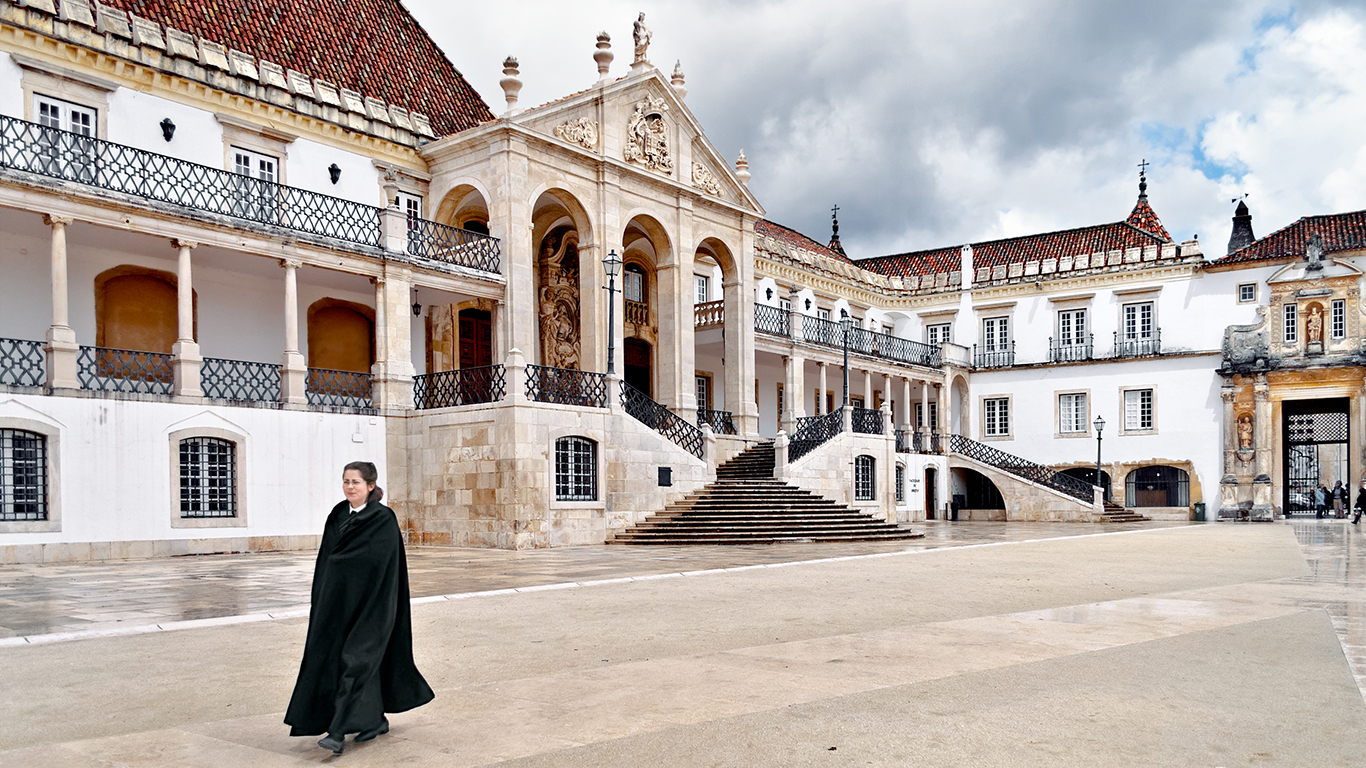 24/7 Wall St.
24/7 Wall St. 24/7 Wall St.
24/7 Wall St.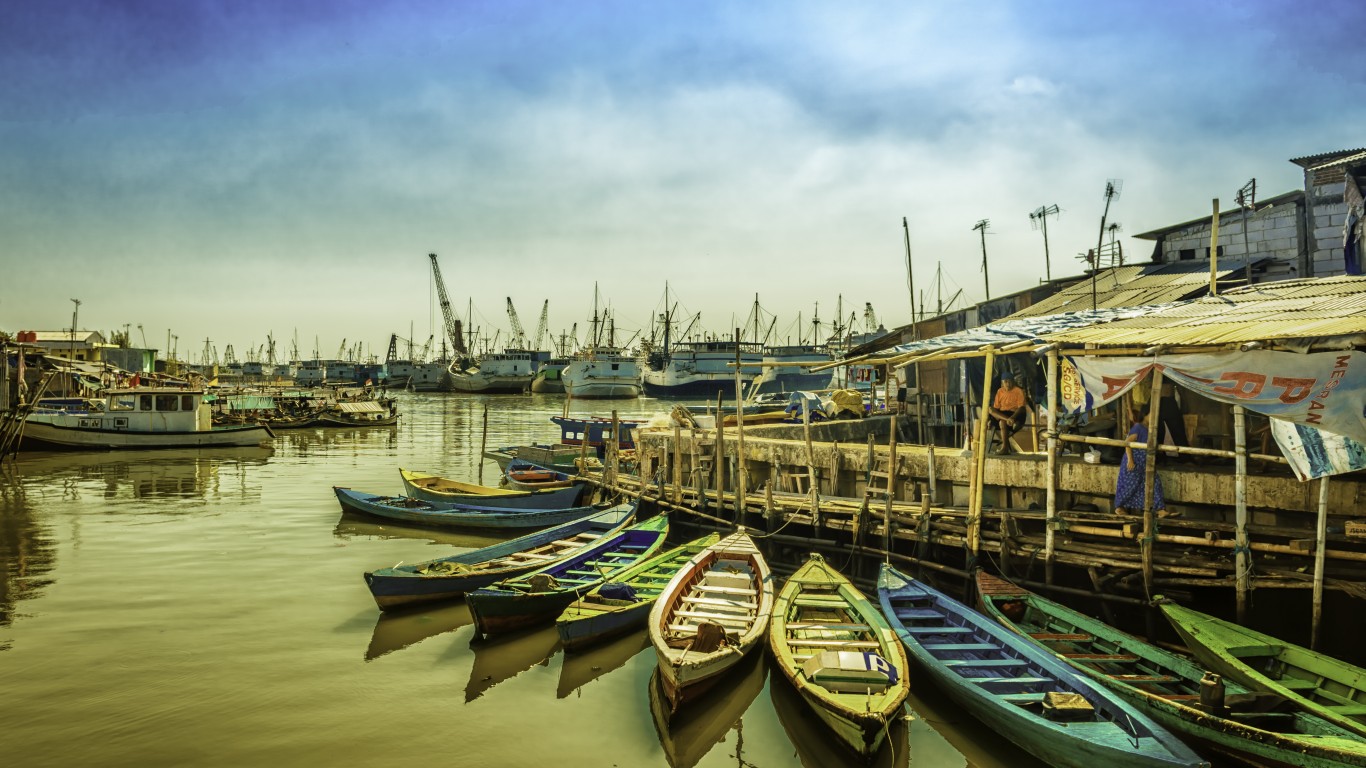 24/7 Wall St.
24/7 Wall St.